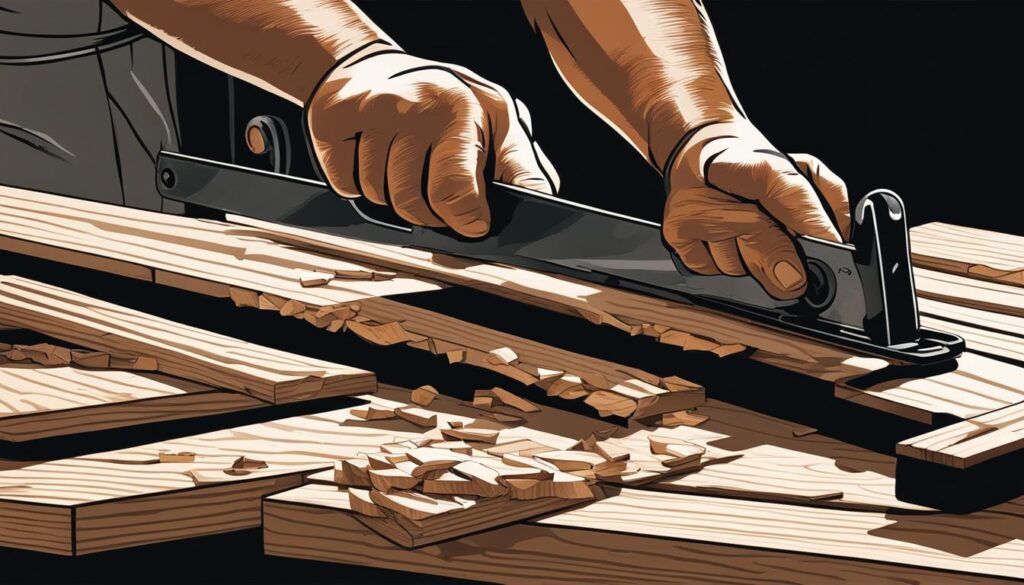We may earn money or products from the companies mentioned in this post.
If you’re a woodworking enthusiast, you know the importance of having an organized workshop. A cluttered and disorganized space can negatively impact your productivity and creativity. Fortunately, with the right workshop organization ideas, you can create a functional and efficient space to tackle all your projects.
From maximizing storage to optimizing your workshop layout, we’ve compiled a list of the best workshop organization tips and ideas to help you take your woodworking game to the next level. Whether you’re a beginner or a seasoned pro, these workshop organization hacks will help you create a workspace that inspires and facilitates creativity.
Key Takeaways
- Organizing your workshop can improve productivity and creativity.
- Maximizing storage and optimizing the workshop layout are key elements of a well-organized workspace.
- Effective tool storage and material organization are crucial for a functional workshop.
- Labeling and inventory management simplify the process of locating tools, materials, and supplies.
- Implementing these workshop organization ideas can enhance your woodworking experience and improve your workflow.
Assess Your Workshop Space
Before diving into the organization process, it’s important to assess your workshop space. A well-planned workshop layout can improve workflow, increase productivity, and facilitate better organization. Here are some workshop layout ideas and organization systems to consider:
1. Create Zones
Establish different zones based on the type of work that will be done in your workshop. For example, create a cutting and assembly area, a finishing area, and a tool storage area. This will help reduce clutter and keep your space organized.
2. Analyze Traffic Flow
Consider the traffic flow in your workshop as you plan your layout. Make sure there is enough room to move around freely and that tools and materials are easily accessible. Keep the workbench and assembly area near the entrance to avoid carrying large materials around the workshop.
3. Optimize Lighting
Make sure your workshop is well-lit to avoid accidents and to improve visibility. Natural lighting is an excellent way to reduce energy costs, but artificial lighting may be necessary to provide adequate illumination in dimly lit areas. Utilize a mix of overhead and task lighting to ensure maximum visibility of your work area.
4. Implement Storage Systems
There are various workshop organization systems that can be tailored to your woodworking needs. Pegboards, shelving units, and cabinets are excellent storage solutions that can keep tools and materials off the floor and organized. Consider purchasing a workbench with integrated storage to maximize your space.
5. Hang It Up
Utilize all available wall space by hanging up frequently used tools, such as saws, hammers, and wrenches. This creates more floor space and makes tools easily accessible. Use magnetic strips, hooks, or specialized tool hangers to keep tools organized and at arm’s reach.
6. Evaluate and Adjust
As your work changes and evolves, so should your workshop layout. Regularly evaluate your workshop and adjust the layout as necessary to improve efficiency and productivity. Continuously searching for new workshop layout ideas and organization systems will help you optimize your workspace and enhance your woodworking experience.
Purge and Declutter
One of the biggest obstacles to workshop organization is clutter. A messy workshop not only makes it difficult to find tools and materials but can also be a safety hazard. By purging and decluttering your workshop, you can create a clean and organized space that enhances your productivity and safety.
Tips for Purging and Decluttering
- Start small: Begin with a single area of your workshop, such as a workbench or storage cabinet, and work your way through the space one section at a time.
- Sort items into categories: Create piles for tools, materials, and supplies that you use frequently, items that you don’t use often, and those that you can donate, sell, or dispose of.
- Use the 6-month rule: If you haven’t used a tool or material in the past six months, consider getting rid of it.
- Donate or sell items: If you have tools or materials that are in good condition, consider donating them to a local vocational school or selling them online.
- Dispose of hazardous materials properly: Paints, chemicals, and other hazardous materials should be disposed of according to local guidelines.
Essential Workshop Organization Supplies
To make the decluttering process easier, it’s important to have the proper supplies on hand. Here are some essential workshop organization supplies to consider:
| Supply | Description |
|---|---|
| Storage bins | Plastic storage bins are great for sorting tools and materials into categories. |
| Label maker | A label maker can help you label storage bins, shelves, and drawers for easy identification. |
| Trash bags | Large trash bags are essential for disposing of unwanted items. |
| Donation box | Use a designated box for items you plan to donate or sell. |
| Cleaning supplies | Having cleaning supplies such as a broom, dustpan, and cleaning solution can help you maintain an organized and tidy workshop. |
By following these workshop organization tips and utilizing the right supplies, you can effectively purge and declutter your workshop, making it a more functional and productive space.
Efficient Tool Storage Solutions
Tools are the cornerstone of any workshop, and proper storage is critical to their accessibility and longevity. The right workshop storage solutions can also help streamline your workflow, saving you time and effort in the process. Here are some clever ideas for efficient tool storage:
- Pegboards: Pegboards are a classic workshop storage solution that can be customized to fit any workspace. These versatile boards can accommodate a variety of hooks, shelves, and baskets to store hand tools, power tools, and accessories. Plus, they allow you to see all your tools at a glance, making it easy to grab what you need and get to work.
- Rolling Tool Cabinets: Rolling tool cabinets are another popular storage option for workshops. These cabinets come in a variety of sizes and configurations, with drawers and shelves that can be customized to fit your tool collection. They also provide the added benefit of mobility, allowing you to move your tools around the workshop as needed.
- Wall-Mounted Cabinets: If space is at a premium in your workshop, wall-mounted cabinets may be the solution. These cabinets can be installed on any sturdy wall surface and are available in a variety of sizes and styles. They provide ample storage for tools and accessories, while keeping the floor clear for other equipment or projects.
No matter which workshop storage solution you choose, there are a few tips to keep in mind:
- Label everything: Clearly label each drawer, shelf, or hook to make it easy to find what you need. Consider using color-coded labels to help organize tools by type or size.
- Keep it clean: Regularly clean and maintain your storage systems to prevent dust, debris, and moisture from damaging your tools.
- Invest in quality: Opt for high-quality storage solutions that can withstand heavy use and keep your tools secure. Cheaper solutions may seem like a good deal, but can cost you more in the long run if they don’t hold up over time.
Optimal Workshop Layout
The layout of your workshop can have a significant impact on your productivity and workflow. By optimizing your workshop layout, you can create an ergonomic working environment that maximizes space and minimizes unnecessary movement. Here are some workshop layout ideas to consider:
1. Zoning
One effective workshop organization system is zoning, which involves dividing your workshop into different areas for specific tasks. For example, you could have a cutting area, an assembly area, and a finishing area. This not only streamlines your workflow but also helps keep your workshop tidy and organized.
2. Traffic Flow
When planning your workshop layout, consider the flow of traffic from one area to another. Arrange your tools and equipment in a way that minimizes movement and promotes efficiency. Additionally, ensure you have adequate space to move around freely and safely.
3. Lighting
Proper lighting is essential in any workshop, as it helps reduce eye strain and improves visibility. When planning your workshop layout, consider the location and type of lighting you need. Utilize natural light if possible and supplement with artificial lighting as needed.
4. Power Sources
Ensure you have adequate power sources in your workshop, including outlets, extension cords, and power strips. Place power sources strategically throughout your workshop to minimize the need for long cords and reduce the risk of tripping hazards.
5. Storage
Proper storage is crucial for an organized workshop. When planning your workshop layout, consider the location and type of storage you need. Utilize vertical space with shelving and pegboards, and ensure your storage is easily accessible and well-organized.
By optimizing your workshop layout, you can create a comfortable, efficient working environment that enhances your woodworking experience. Consider these workshop layout ideas and experiment with different organization systems to find what works best for you.
Material and Supplies Organization
Keeping your materials and supplies organized is key to maintaining an efficient workshop. Here are some helpful workshop organization tips:
- Sort by Category: Group similar materials together, such as lumber, hardware, and finishing supplies. This makes it easier to find what you need and helps prevent unnecessary purchases.
- Label Everything: Use clear and concise labels to identify each material and its category. This saves time and reduces the risk of misplacing items.
- Use Storage Containers: Keep your materials and supplies in labeled storage containers. This makes it easy to find what you need, keeps your workspace tidy, and protects your materials from damage.
When organizing your materials and supplies, it’s also important to have the right workshop organization supplies:
| Supply | Description |
|---|---|
| Label Maker | A tool that prints clear and durable labels for your materials and supplies. |
| Storage Containers | Containers that come in various sizes and shapes to store materials and supplies. |
| Shelving Units | Shelves that can be mounted on the wall or free-standing, providing ample storage space for materials and supplies. |
| Pegboard | A board with pre-drilled holes where you can insert hooks to hang tools and supplies, keeping them organized and easily accessible. |
With proper organization and the right supplies, you can ensure your materials and supplies are easily accessible and well-protected, making your workshop a more efficient and productive space.
Labeling and Inventory Management
One of the most critical aspects of workshop organization is labeling and inventory management. By creating a streamlined system for identifying and locating tools, materials, and supplies, you can save time and reduce frustration. Here are some workshop organization tips and materials that can help make inventory management a breeze.
Efficient Labeling Techniques
Effective labeling is essential for finding tools and supplies quickly and easily. Here are some practical workshop organization tips for labeling:
- Use clear and concise labels with large font sizes
- Label all drawers and containers with a detailed description of the contents inside
- Use color-coding to differentiate between tool types or project stages
- Label power cords and cables to avoid confusion between different devices
By incorporating these labeling techniques into your workshop organization system, you can create a clear and efficient way to locate the tools and materials you need. For a more detailed inventory management solution, consider a workshop organization product.
Workshop Organization Supplies for Inventory Management
Several workshop organization supplies can help you manage inventory more efficiently. Here are some of the most popular materials:
| Material | Description |
|---|---|
| Label Maker | A tool that creates adhesive labels with customized text and symbols |
| Pegboard and Hooks | A board with evenly spaced holes that can be used with various hooks to organize tools and supplies on a wall |
| Drawer Dividers | Plastic or metal barriers that fit into drawers, dividing them into small compartments to organize smaller tools or materials |
| Tool Chests and Cabinets | Sturdy cabinets with multiple drawers and compartments to store larger tools and power tools |
By incorporating these workshop organization supplies into your inventory management system, you can ensure that all your tools and supplies are organized and easy to find. With a well-organized workshop, you can focus on your woodworking projects and become more productive.
Conclusion
In conclusion, organizing your workshop is essential to optimize your space and enhance productivity. By implementing effective workshop organization ideas, you can transform your cluttered space into an organized and efficient working environment. Utilize innovative workshop storage solutions, practical workshop organization tips and hacks, and workshop organization supplies to simplify the organization process.
Proper tool storage is crucial for a well-organized workshop, so consider different workshop tool storage solutions that can save space and streamline your workflow. Additionally, assess your workshop space and layout to identify areas for improvement and create an ergonomic working environment.
Material and supplies organization and inventory management are other essential components of workshop organization. Discover practical workshop organization tips for sorting and storing materials and supplies, including lumber, hardware, and finishing supplies. Efficient labeling techniques and workshop organization supplies can streamline inventory management and save time.
Incorporate these workshop organization ideas, workshop layout ideas, and workshop organization systems into your workshop organization journey to create a space that inspires creativity and efficiency. With these changes, you will surely enjoy your woodworking experience more.
FAQ
What are workshop organization ideas?
Workshop organization ideas are strategies and techniques implemented to optimize and enhance the functionality of a workshop space. They can include storage solutions, layout designs, decluttering methods, and inventory management systems.
Why is workshop organization important?
Workshop organization is important because it allows for efficient workflow, saves time, and reduces frustration. By having a well-organized workshop, you can easily locate tools, materials, and supplies, leading to increased productivity and a more enjoyable work environment.
What are some workshop storage solutions?
Workshop storage solutions can include wall-mounted shelves, pegboards, tool cabinets, rolling carts, and storage bins. These solutions help keep tools and materials organized and easily accessible.
How should I assess my workshop space?
When assessing your workshop space, consider factors such as the layout, available square footage, existing storage areas, and the types of tools and equipment you use. This evaluation will help you identify areas for improvement and determine the most effective organization strategies.
What are some workshop organization tips for decluttering?
Some workshop organization tips for decluttering include sorting tools and materials into categories, getting rid of items you no longer use or need, creating designated storage spaces, and regularly maintaining and organizing your workspace.
How can I optimize my workshop layout?
To optimize your workshop layout, consider factors such as workflow efficiency, ergonomic positioning of workstations, and maximizing the use of available space. Explore different layout ideas, such as U-shape, L-shape, or parallel layouts, to find the most suitable configuration for your needs.
What workshop organization supplies do I need?
Workshop organization supplies can include storage bins, label makers, drawer dividers, hooks, tool holders, and shelving units. These supplies help you keep your workshop organized and maintain a systematic inventory management system.
How can labeling and inventory management benefit my workshop organization?
Labeling and inventory management systems make it easier to locate tools, materials, and supplies in your workshop, saving time and reducing frustration. By labeling storage areas and implementing an inventory management system, you can maintain a well-organized workspace and streamline your workflow.
What are some workshop organization hacks?
Some workshop organization hacks include repurposing household items as storage solutions, using magnetic strips to hold tools, utilizing vertical space with overhead storage, and creating customized storage solutions based on your specific needs and preferences.
Affiliate Disclosure: This post may contain affiliate links. If you purchase through our link, we may receive a small commission, but at no additional cost to you. For more information, please see our Disclosure statement.



